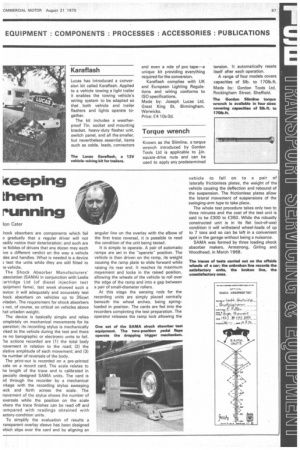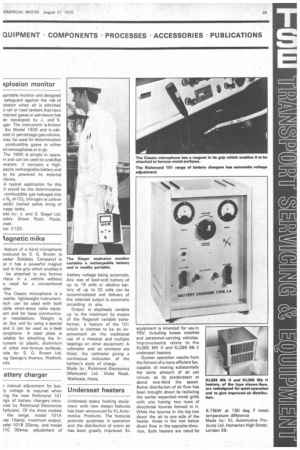teeping them running
Page 69

Page 71

If you've noticed an error in this article please click here to report it so we can fix it.
ion Cater ,hock absorbers are components which fail D gradually that a regular driver will not )adily notice their deterioration; and such are le foibles of drivers that any dozen may each lye a different verdict on the way a vehicle des and handles. What is needed is a device ) test the units while they are still fitted to le vehicle.
The Shock Absorber Manufacturers' iSsociation (SAMA) in conjunction with Leslie lartridge Ltd (of diesel injection test quipment fame), last week showed such a levice: it will adequately and accurately test hock absorbers On vehicles up to 35cwt inladen. The requirement for shock absorbers s not, of course, so critical on vehicles above Hat unladen weight.
The device is basically simple and relies ompletely on mechanical movements for its Iperation; its recording stylus is mechanically nked to the vehicle during the test and there re no barographic or electronic units to fail. 'he actions recorded are (1) the total body novement in relation to the road; (2) the elative amplitude of each movement; and (3) He number of reversals of the body.
The print-out is recorded on a pre-printed cale on a record card. The scale relates to He length of the trace and is calibrated in pecially designed SAMA units. The card is ad through the recorder by a mechanical nkage with the recording stylus sweeping lack and forth across the scale. The novement of the stylus shows the number of eversals while the position on the scale vhere the trace finishes can be read off and ;ompared with readings obtained with actory-condition units.
To simplify the evaluation of results a ransparent overlay sleeve has been designed vhich slips over the card and by aligning an angular line on the overlay with the elbow of the first trace reversal, it is possible to read the condition of the unit being tested.
It is simple to operate. A pair of automatic ramps are set in the "operate" position. The vehicle is then driven on the ramp, its weight causing the ramp plate to slide forward while raising its rear end. It reaches its maximum movement and locks in the raised position, allowing the wheels of the vehicle to roll over the edge of the ramp and into a gap between a pair of small-diameter rollers.
At this stage the sensing rods for the recording units are simply placed centrally beneath the wheel arches, being springloaded in position. The cards are fed into the recorders completing the test preparation. The operator releases the ramp lock allowing the vehicle to fall on to a pair of laterally frictionless plates, the weight of the vehicle causing the deflection and rebound of the suspension. The frictionless plates allow the lateral movement of suspensions of the swinging-arm type to take place.
The whole test procedure takes only two to three minutes and the cost of the test unit is said to be £300 to £350. While the robustly constructed unit is in its flat (out-of-use) condition it will withstand wheel-loads of up to 7 tons and so can be left in a convenient spot in the garage without being a nuisance.
SAMA was formed by three leading shock absorber makers, Armstrong, Girling and Woodhead. in March 1968. portable monitor unit designed safeguard against the risk of plosion when air is admitted o rail or road tankers that have ntained gases or petroleum has en developed by J. and S. .iger. The instrument is known the Model 1900 and is caliited in percentage gas volume. may be used for determination combustible gases in either art atmospheres or in air.
The 1900 is simple in operain and can be used by unskilled ierators. It contains a highpacity rechargeable battery and ay be powered by external tteries.
A typical application for this it would be the determination combustible gas leakages into a N2 of CO, (nitrogen or carbon )xide) inerted safety lining of 3rage tanks.
ade by: J. and S. Sieger Ltd, anley Green Road, Poole, )rset.
ice: £120.
lagnetic mike
feature of a hand microphone troduced by S. G. Brown (a awker Siddeley Company) is at it has a powerful magnet ted in the grip which enables it be attached to any ferrous irface in a vehicle, without e need for a conventional Ader.
The Classic microphone is a irsatile. lightweight instrument, hich can be used with both obile short-wave radio equipent and for base communica)n installations. Weight is ily 5oz and by using a special and it can be used as a desk icrophone. A steel plate is reliable for attaching the inrument to plastic, aluminium Id other non-ferrous surfaces. ade by: S. G. Brown Ltd, ng George's Avenue, Watford, arts.
.attery charger D manual adjustment for batry voltage is required when .ing the new Richmond 101 nge of battery chargers introiced by Richmond Electronics larkyate). Of the three models
the range, model 101A ves 10amp. maximum output. odd l 101B 20amp. and model )1C 30amp, adjustment of battery voltage being automatic. Any size of lead-acid battery of up to 16 cells or alkaline battery of up to 32 cells can be accommodated and delivery of the selected output is automatic according to size.
Output is steplessly variable up to the maximum by means of the Regavolt variable transformer, a feature of the 101 which is claimed to be an improvement on the traditional use of a rheostat and multiple tappings on other equipment. A voltmeter and an ammeter are fitted, the voltmeter giving a continuous indication of the battery's state of charge.
Made by: Richrnond Electronics (Markyatel Ltd. Hicks Road, Markyate, Herts.
Underseat heaters
Underseat Space heating equipment with new design features has been announced by KLAutomotive Products. The features promote quietness in operation and the distribution of warm air has been greatly improved. KL equipment is intended for use in PSV, including buses, coaches and personnel-carrying vehicles. Improvements relate to the KL385 MK II and KL386 Mk II underseat heaters.
Quieter operation results from the fitment of a more efficient fan, capable of moving substantially the same amount of air per minute as its predecessor at about one-third the speed. Better distribution of air flow has been brought about by replacing the earlier expanded-metal grille with one having two rows of directional louvres formed in it. While the louvres in the top row direct the air to one side of the heater, those in the row below divert flow in the opposite direction. Both heaters are rated for 6,75kW at 150 deg F mean temperature difference Made by: KL Automotive Products Ltd, Homerton High Street, London E9.














































































































